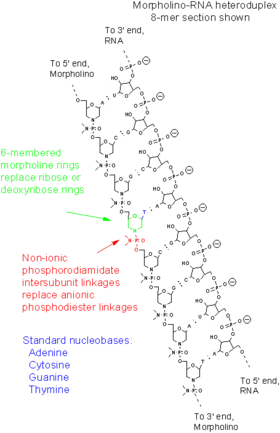嗎啉基
嗎啉基又稱嗎啉(英語:Morpholino),是一種用來修飾基因表現的分子,嗎啉基寡核苷酸是一種反義技術,可用來阻礙其他分子與特定核酸序列的結合。可阻擋RNA上約25個鹼基的區域。此分子可應用在一些模式生物的研究上,包括小鼠、斑馬魚、非洲爪蟾等[1]。

嗎啉基與RNA混合形成的結構片段
除了組合成寡核苷酸之外,嗎啉基也可能出現在其他分子中。但「Morpholino」指其寡核苷酸形式,也就是磷醯二胺嗎啉代寡核苷酸(phosphorodiamidate morpholino oligomers,PMO)。吗啉基是对天然核苷酸结构重新设计获得的合成分子。长度多为25个碱基,以标准核苷酸碱基配对的方式与RNA互补结合。在结构上来看,吗啉基与DNA的区别在于尽管前者有标准的核苷酸碱基,这些碱基却连接在吗啉环上,而非脱氧核糖环。吗啉通过占据体内mRNA与其它分子作用位点来发生作用。
參見
- 嗎啉
參考文獻
- Heasman J. . Dev. Biol. 2002, 243 (2): 209–14. PMID 11884031.
延伸閱讀
- Wiley-Liss, Inc. Special Issue: Morpholino Gene Knockdowns of genesis Volume 30, Issue 3 Pages 89-200 (July 2001). A special issue of Genesis, comprised of a series of peer-reviewed short papers utilizing morpholino knock downs of gene function in various animal and tissue culture systems.
- Moulton, Jon, , Beaucage, Serge (编), , New Jersey: John Wiley & Sons, Inc., 2007, ISBN 978-0-471-24662-6
This article is issued from Wikipedia. The text is licensed under Creative Commons - Attribution - Sharealike. Additional terms may apply for the media files.